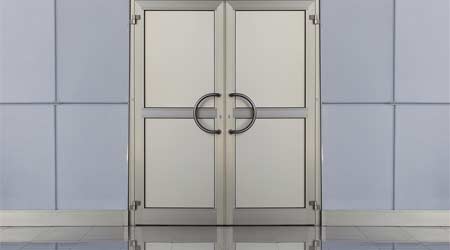In Planning Doors, Expect Abuse, Heavy Use, and Possible Code Issues
Part 2 of a 3-part article on how to select the right door and maintain it, including a roundup of door products
During the planning stages for doors, or if door alterations are being contemplated, it’s essential to think about the level of abuse the door will get, as well as the possibility of introducing code issues and compromising quality in order to reduce expense.
Doors in hospital hallways will have gurneys and carts banged against them. At service entrances to apartment buildings, "they’re going to use Dumpsters to open those doors," Clancy says. Hotel room doors are in constant use, get banged with luggage, and are self-closing — and any self-closing door is subject to more abuse because of the force needed to open it.
In some facilities, deliberate abuse is part of normal wear and tear. Jails have reinforced doors with high security. But, says Heinz, "you have guys sitting there all day thinking about nothing else but how to get through that door, and sometimes they do." Even if abuse is not actively malicious, it can still create a problem. Heinz says that to prop a door open, teachers will frequently jam a book into the hinge-side crack between the door and the frame. "We’ve replaced so many doors because the hinge can’t handle that kind of force," he says. Maintenance and repair is easier when problems first appear, but often the end users don’t think to report minor problems, Heinz says, and instead wait until something fails completely.
"A well-maintained space could have two or three levels of durability, depending on its location in the building," White says. Exterior doors, with heavy traffic and abuse, must be both heavy-duty and attractive; closet doors can be lightweight. The door to a board room can be lightweight, but it needs a high-end veneer over its body.
Complications Arise
If the purpose of a door changes, the door may be altered too, properly or not. Sometimes occupants decide a room needs more security and drill in their own deadbolt, which "violates a lot of codes," Sabatini says. Facility managers need to talk to the end users about any potential issues, and to maintenance staff about what parts cause problems and how quickly they can be ordered.
One school’s vandalism problem was solved by putting classroom door locks on an electronic system, with latches held open during the day and locked after school, although teachers still had access, says Heinz. That system provides benefits in a fire or a security lockdown, since all doors in the building can be locked on one command.
But equipment for lockdowns violates code if the system requires the teacher to perform more than one action to open the door from the inside — and it could cause a bigger problem if the teacher is incapacitated and the door can’t be opened from the outside.
Lori Greene, a member of NFPA 80 technical committee on fire doors and windows who represents the Door and Hardware Institute, says that the market is full of cheap systems that are "the equivalent of chaining or padlocking the door closed."
A better choice is a system that allows an authorized person to open the door from the outside, whether with a key, an electronic fob, or a command from the office, says Greene, who is also manager of codes and hardware for Allegion.
David Lewellen is a freelance writer who covers facility issues.
Related Topics:














